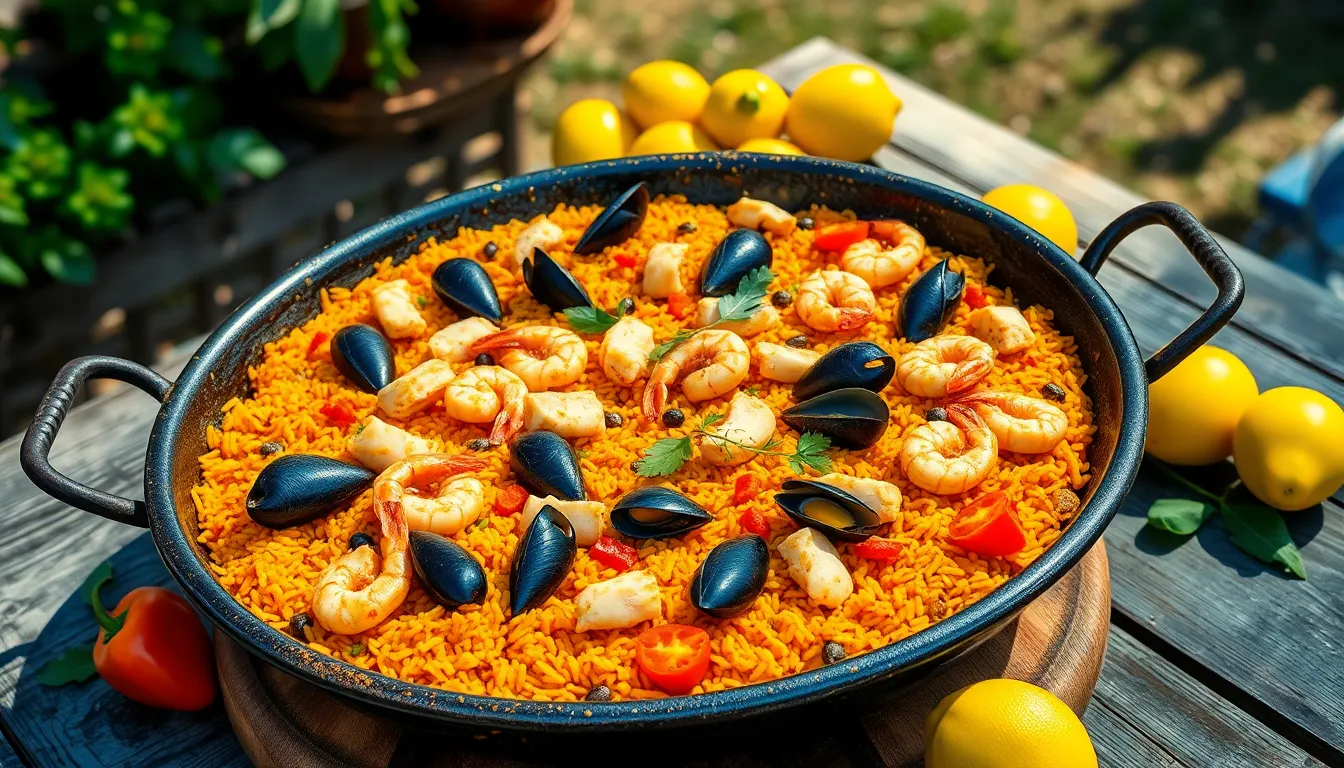What is Paella?
Paella stands as Spain’s most iconic rice dish, originating from the Valencia region in the 15th century. You’ll discover this traditional one-pan meal represents far more than simple comfort food—it embodies centuries of Spanish culinary tradition and cultural identity.
The dish gets its name from the wide, shallow pan called a “paellera” in which you prepare it. This specialized cooking vessel allows the rice to spread in a thin layer, creating the perfect texture and the coveted crispy bottom layer known as socarrat. Valencia’s farmers originally created paella as a hearty meal combining readily available ingredients from their land and nearby Mediterranean waters.
Three main varieties of paella dominate Spanish cuisine today. Paella Valenciana features rabbit, chicken, green beans, lima beans, and saffron as its cornerstone ingredients. Paella de Mariscos showcases fresh seafood including shrimp, mussels, clams, and sometimes squid or lobster. Mixed paella combines both meat and seafood elements, though purists often debate its authenticity.
Saffron serves as paella’s golden signature spice, providing both the distinctive yellow color and subtle floral flavor that defines authentic versions. You’ll find this precious spice costs more than gold by weight, but its unique taste profile cannot be replicated by cheaper substitutes like turmeric or paprika.
The cooking technique requires patience and attention to detail. You build layers of flavor by first creating a sofrito base with onions, garlic, and tomatoes, then adding your proteins and vegetables before incorporating the rice and saffron-infused broth. The rice cooks without stirring, allowing it to absorb the liquid slowly while developing that prized crispy bottom crust.
Regional variations throughout Spain showcase local ingredients and preferences. Catalonian versions might include white beans and artichokes, while Andalusian interpretations feature different seafood combinations. Each region proudly claims its own authentic approach to this beloved dish.
Types of Paella
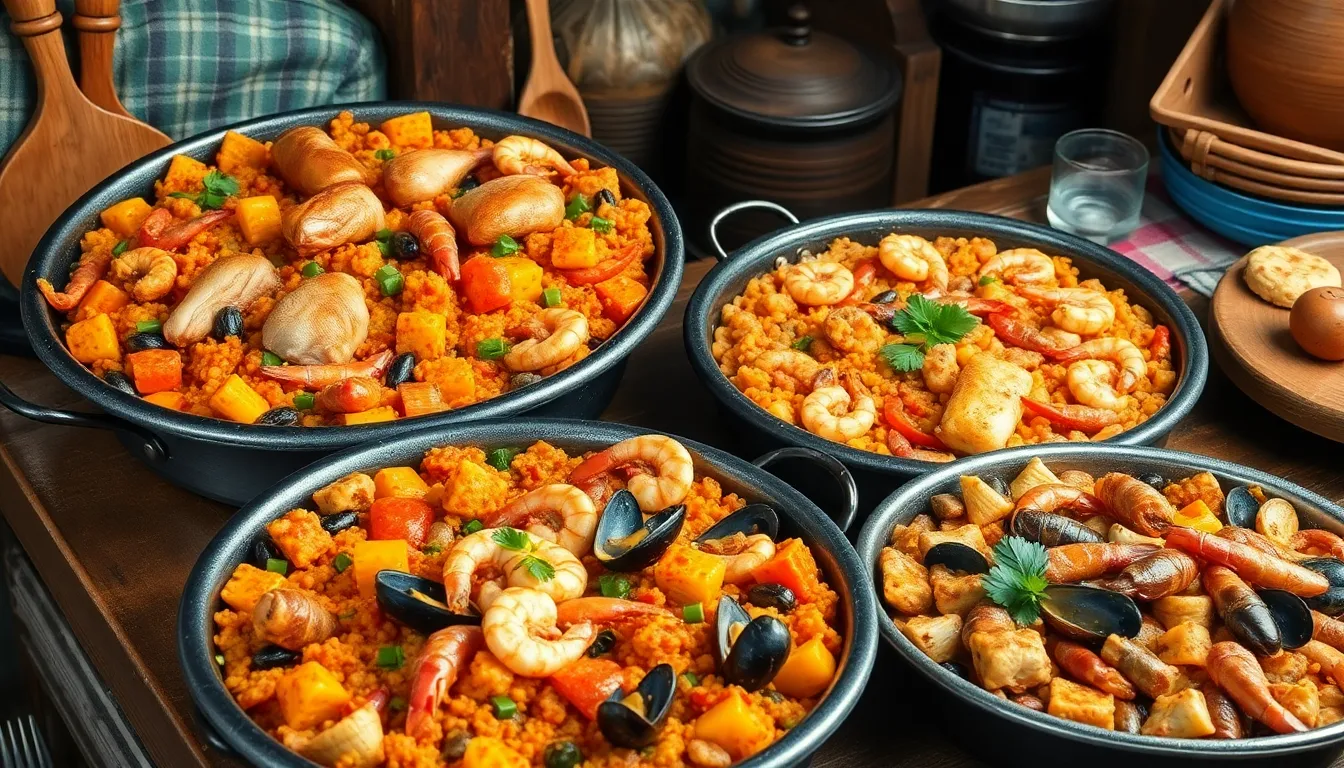
Paella comes in several distinct varieties that reflect Spain’s diverse regional preferences and available ingredients. Each type follows the same fundamental cooking technique while showcasing unique flavor profiles and ingredient combinations.
Traditional Valencian Paella
You’ll find the most authentic version in Valencia’s original recipe that dates back centuries. This classic preparation features rabbit, chicken, lima beans (garrofón), green beans, tomatoes, and rosemary as the primary ingredients. Rice serves as the foundation while saffron provides the signature golden color and distinctive flavor.
The traditional method requires you to brown the meat first before adding vegetables and rice. Snails often appear in authentic versions, though many modern interpretations omit them. You must resist the temptation to add seafood or other proteins, as purists consider this a departure from the true Valencian style.
Seafood Paella
Coastal regions inspired this popular variation that showcases the Mediterranean’s abundant marine offerings. Your seafood paella should include prawns, mussels, clams, and sometimes langostines or crab. Fish stock replaces the chicken stock used in traditional versions, creating a briny base that complements the seafood perfectly.
You’ll build layers of flavor by sautéing garlic and adding tomatoes before incorporating the rice. Green beans and red peppers provide color and texture contrast to the seafood. The cooking process remains similar, but you must time the seafood additions carefully to prevent overcooking the delicate proteins.
Mixed Paella
This versatile version combines elements from both traditional and seafood varieties, offering the best of both worlds. You can include chicken, rabbit, prawns, mussels, and vegetables in one harmonious dish. Many restaurants serve this style because it appeals to diverse preferences and dietary needs.
Your mixed paella requires careful coordination of cooking times since different proteins need varying preparation periods. Start with the meat, add vegetables, then incorporate seafood during the final stages. This approach ensures each ingredient reaches optimal doneness without compromising texture or flavor.
Essential Equipment
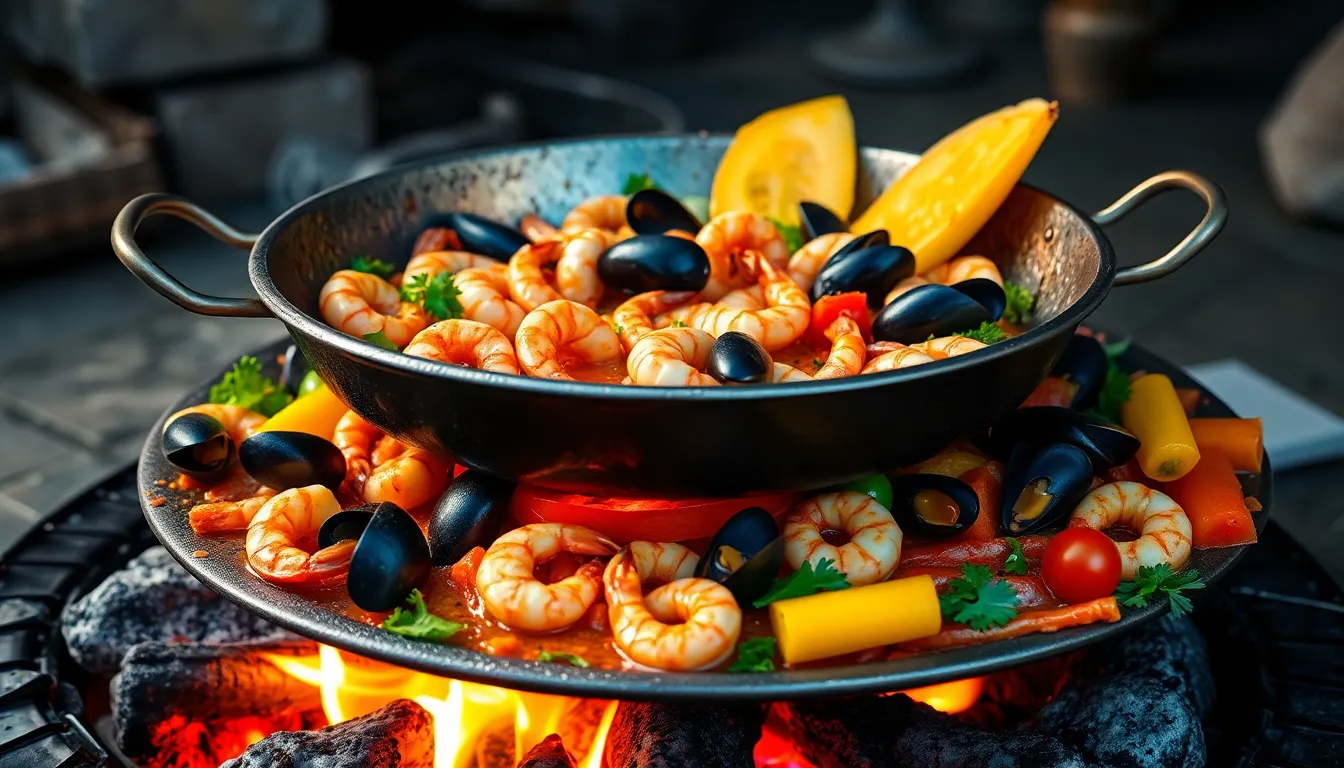
Creating authentic paella requires exact equipment that ensures proper cooking techniques and traditional results. The right tools make the difference between a mediocre rice dish and an exceptional paella worthy of Valencia’s culinary standards.
Paella Pan
You need a wide shallow pan called a paellera to achieve the signature thin layer of rice that defines authentic paella. Traditional paelleras range from 12 inches for 4 servings to 22 inches for large gatherings. The wide surface area allows rice to cook evenly in a single layer while developing the coveted socarrat bottom crust.
Carbon steel paelleras offer the best heat distribution and develop natural nonstick properties over time. Stainless steel versions work well for beginners and require less maintenance. Avoid nonstick coated pans as they cannot withstand the high heat needed for proper socarrat formation.
Choose your pan size based on serving portions using this guide:
| Pan Diameter | Servings | Rice Amount |
|---|---|---|
| 12 inches | 3-4 people | 1.5 cups |
| 15 inches | 6-8 people | 2.5 cups |
| 17 inches | 8-10 people | 3.5 cups |
| 20 inches | 12-15 people | 5 cups |
Heat Source
Your heat source determines how evenly your paella cooks and whether you achieve that prized crispy bottom layer. Gas burners provide the most control over heat distribution and allow you to adjust flame intensity quickly. Professional paella burners with multiple rings ensure even heating across large pans.
Electric stovetops work for smaller paelleras but may create hot spots that burn the rice. Place a heat diffuser under your pan to distribute heat more evenly on electric ranges. Outdoor gas burners designed specifically for paella offer the most authentic cooking experience and accommodate larger pans effectively.
Wood fired cooking gives the most traditional flavor but requires experience to maintain consistent temperatures. Start with medium high heat to build your sofrito base then reduce to medium low for the rice cooking phase. Never move or stir the pan during the final cooking stages to allow proper socarrat development.
Ingredients
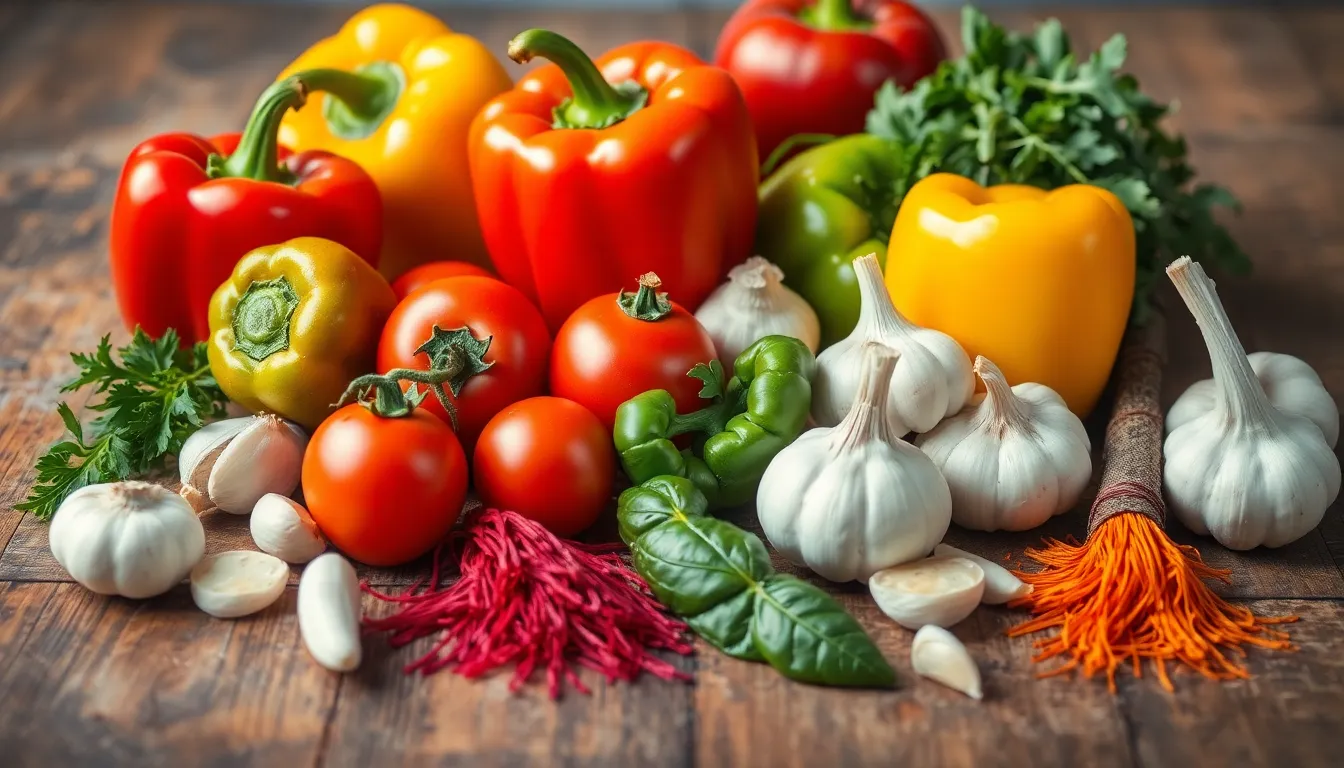
Creating authentic paella requires carefully selected ingredients that work together to build layers of complex flavor. Each component serves a exact purpose in achieving the perfect balance of taste and texture.
For the Sofrito Base
Your sofrito forms the foundation of exceptional paella and requires these essential aromatics:
- 4 tablespoons extra virgin olive oil
- 1 large onion, finely diced
- 4 garlic cloves, minced
- 2 large ripe tomatoes, grated (discard skins)
- 1 red bell pepper, cut into strips
- 1 teaspoon sweet paprika (pimentón dulce)
- Pinch of saffron threads
Rice and Broth
The rice and liquid components determine your paella’s final texture and flavor:
- 2 cups Spanish short grain rice (Bomba or Calasparra preferred)
- 4 to 5 cups warm chicken or seafood broth
- 1/2 cup dry white wine
- Salt to taste
- 1 bay leaf
Protein Options
Choose one protein combination based on your preferred paella style:
Traditional Valencian:
- 1 whole chicken, cut into 8 pieces
- 1 pound rabbit, cut into pieces
- 1/2 pound green beans, trimmed
Seafood Paella:
- 1 pound large shrimp, shell on
- 1 pound mussels, cleaned and debearded
- 1/2 pound squid, cleaned and sliced into rings
- 1/2 pound firm white fish, cut into chunks
Mixed Paella:
- 1/2 pound chicken thighs, cut into pieces
- 1/2 pound shrimp, shell on
- 1/2 pound mussels, cleaned
- 1/4 pound chorizo, sliced
Vegetables and Seasonings
- 1 cup lima beans or garrofó beans (for traditional)
- 1/2 cup roasted red peppers, cut into strips
- 1/4 cup fresh parsley, chopped
- 2 lemons, cut into wedges
- Black pepper to taste
- Optional: artichoke hearts, green peas
Preparation Steps

Master these essential preparation steps to create authentic paella that rivals any Spanish kitchen. Proper mise en place and technique will set the foundation for your perfect paella.
Prep the Ingredients
Gather all ingredients before you begin cooking to ensure smooth execution. Heat your chicken or seafood broth in a separate pot and keep it warm throughout the cooking process.
Soak the saffron threads in 2 tablespoons of warm broth for 10 minutes to release their golden color and aromatic oils. Dice the onion finely and mince 4 garlic cloves for your sofrito base.
Grate the tomato on the large holes of a box grater and discard the skin. Cut the bell pepper into thin strips and measure out your paprika and seasonings.
Prepare your proteins by cutting chicken into bite-sized pieces and cleaning seafood thoroughly. Pat all proteins dry with paper towels to prevent excess moisture during cooking.
Measure the rice and have it ready to add when needed. Open any canned ingredients like lima beans and drain them properly.
Make the Sofrito
Heat 1/4 cup of olive oil in your paellera over medium heat until it shimmers. Add the diced onion and cook for 3-4 minutes until it becomes translucent and fragrant.
Incorporate the minced garlic and cook for another minute until aromatic. Be careful not to let the garlic brown or it will become bitter.
Add the grated tomato and bell pepper strips to the pan. Cook this mixture for 5-6 minutes while stirring occasionally until the tomato reduces and darkens slightly.
Sprinkle in 1 teaspoon of sweet paprika and stir constantly for 30 seconds to prevent burning. The paprika should become fragrant and coat the vegetables evenly.
Pour in the saffron mixture along with its soaking liquid. Stir everything together until the sofrito takes on a beautiful golden hue and the flavors meld together.
Cook the Proteins
Season your chicken pieces with salt and pepper before adding them to the sofrito. Cook the chicken for 6-8 minutes while turning occasionally until all sides are golden brown.
Push the chicken to one side of the pan and add seafood in order of cooking time required. Start with firm fish pieces and cook for 2-3 minutes per side.
Add shrimp and cook for 1 minute per side until they turn pink and begin to curl. Remove the shrimp temporarily to prevent overcooking.
For mixed paella add mussels and clams directly to the pan. They will open during the rice cooking process and release their natural juices.
Create an even layer with all proteins distributed across the paellera. This ensures each portion of rice will absorb the flavors from the proteins above it.
Season the entire mixture with salt and pepper to taste. The proteins should be about 80% cooked at this stage since they will finish cooking with the rice.
Instructions
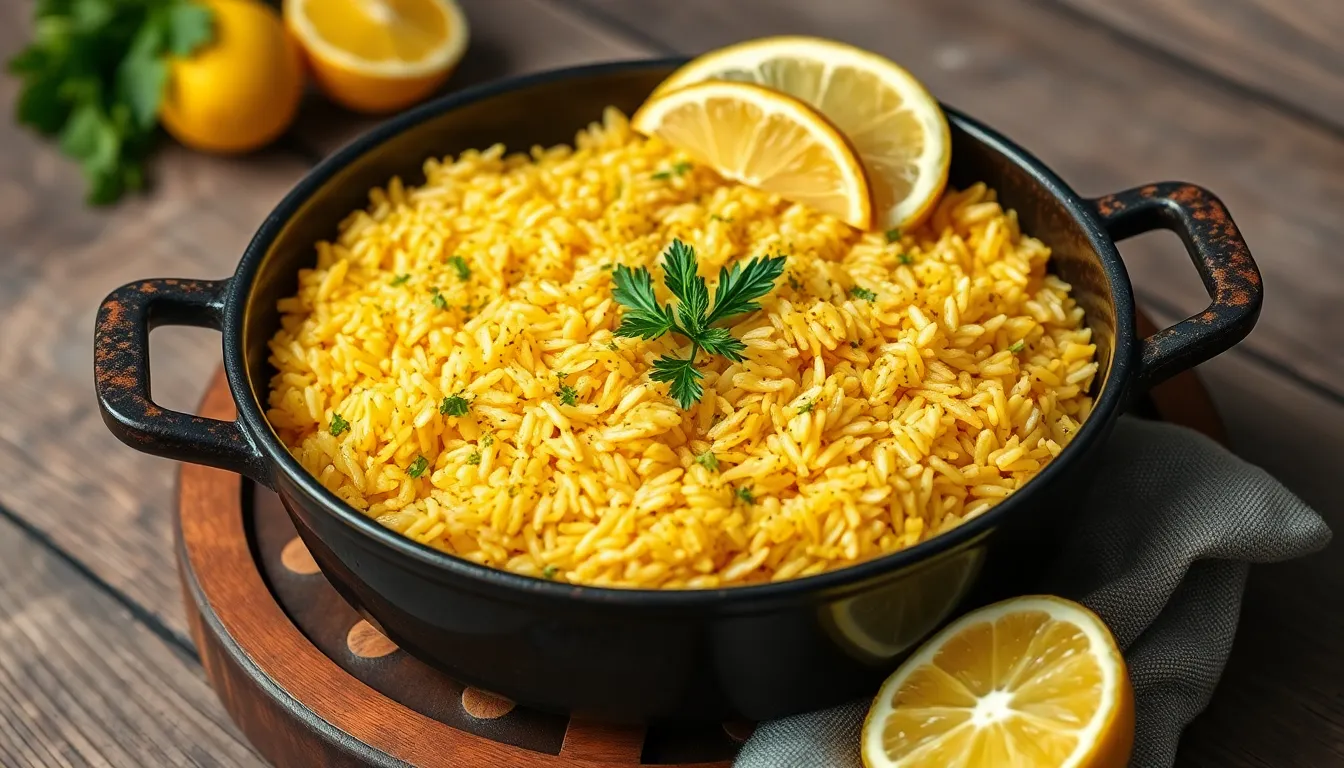
Follow these step-by-step instructions to create authentic paella with perfect texture and flavor. Master each phase to achieve the signature golden rice and coveted socarrat.
Building the Base
Heat your paellera over medium-high heat until it becomes evenly warm across the entire surface. Add 4 tablespoons of olive oil and swirl to coat the pan completely. The oil should shimmer but not smoke.
Add your prepared sofrito base to the heated oil and cook for 2-3 minutes until fragrant. Stir the mixture gently to prevent sticking. The onions should become translucent and the tomatoes should break down slightly.
Pour the saffron-infused broth gradually into the sofrito while stirring continuously. The mixture will bubble vigorously at first. Add your cooked proteins back to the pan and distribute them evenly across the surface. Season with salt and white pepper to taste.
Adding Rice and Broth
Sprinkle the rice evenly across the entire surface of the paellera without stirring. Use a wooden spoon to gently push the rice into the liquid if needed. The rice should form a thin even layer approximately 1/2 inch deep.
Bring the mixture to a rolling boil over high heat. You should hear active bubbling throughout the pan. Reduce heat to medium-low once boiling begins. The liquid should maintain gentle simmering without violent bubbling.
Cook for 18-20 minutes without stirring or moving the pan. The rice will absorb the broth gradually during this time. Add vegetables like green beans or lima beans during the final 10 minutes of cooking. Rotate the pan occasionally to ensure even heat distribution.
Creating the Socarrat
Listen for subtle crackling sounds coming from the bottom of the pan during the final 5 minutes of cooking. This indicates the socarrat is forming properly. Increase heat to medium-high for the last 2-3 minutes to intensify the crackling.
Check the socarrat by lifting a corner of rice with a wooden spoon. The bottom layer should appear golden brown and smell toasted but not burned. Remove the pan from heat immediately once you achieve the desired color.
Cover the paellera with a clean kitchen towel and let it rest for 5 minutes. This resting period allows the rice to finish cooking with residual heat. Serve directly from the paellera with lemon wedges and fresh herbs.
Cooking Tips for Perfect Paella
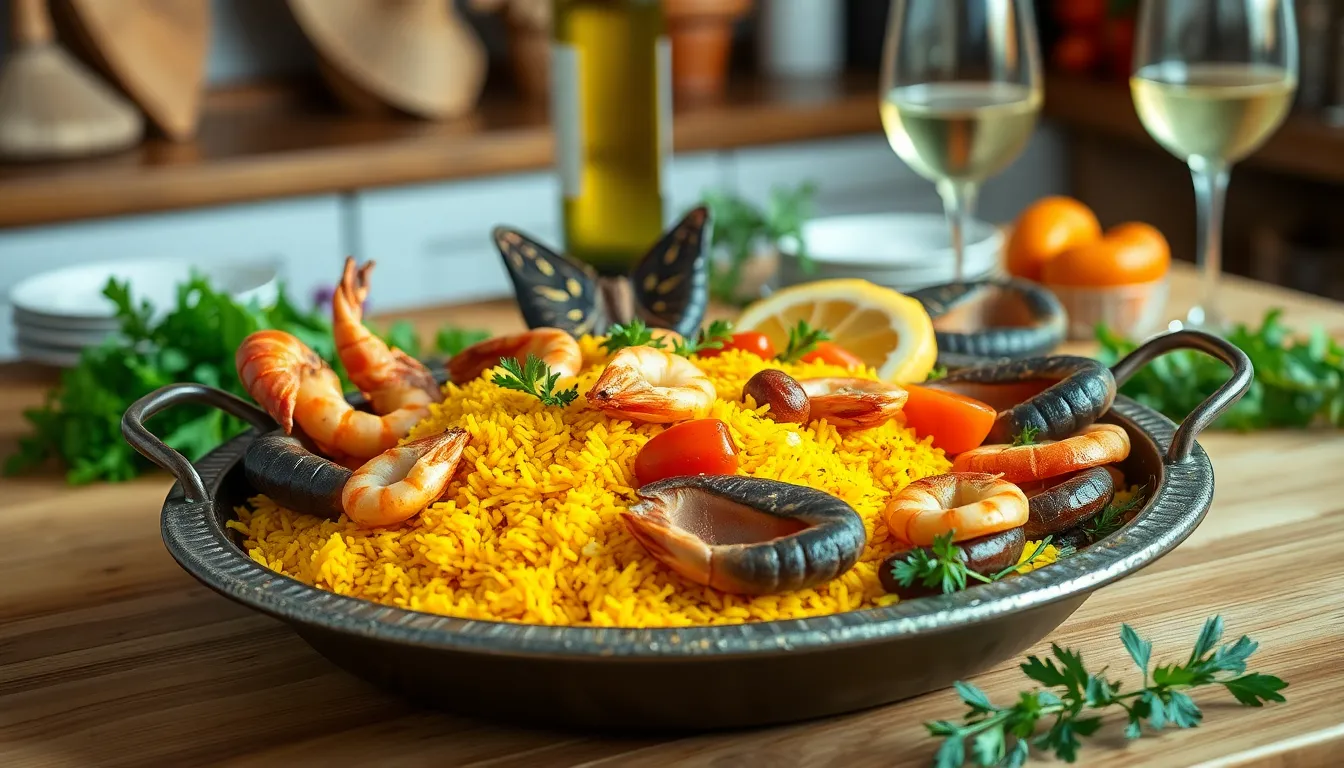
Mastering paella requires attention to exact techniques that separate authentic Spanish cooking from ordinary rice dishes. These proven tips will help you achieve restaurant-quality results in your own kitchen.
Temperature Control
Begin cooking your paella over medium-high heat to establish the sofrito base properly. Your paellera should reach approximately 350-375°F for optimal ingredient caramelization and flavor development.
Reduce heat to medium once you add the rice and broth to maintain gentle simmering throughout the cooking process. Monitor the pan carefully as different stovetops distribute heat differently across the wide surface.
Increase heat to medium-high during the final 2-3 minutes to create the coveted socarrat. Listen for subtle crackling sounds that indicate the bottom layer is crisping without burning.
Use a heat diffuser on electric stovetops to ensure even temperature distribution across your paellera’s wide bottom. Gas burners provide superior control but require adjustment based on your exact flame intensity.
Rice Distribution
Spread rice evenly across the paellera using a wooden spoon immediately after adding it to the sofrito. Create a uniform layer approximately 1/2 inch thick for consistent cooking results.
Resist the urge to stir rice once you’ve added the broth and established your initial distribution. Stirring releases starch and creates a risotto-like texture instead of the distinct grain separation paella requires.
Gently shake the pan occasionally to redistribute rice and prevent uneven cooking spots. This motion helps achieve uniform absorption without disturbing the grain structure.
Add proteins and vegetables strategically across the rice surface to ensure balanced flavor distribution in every serving. Press larger ingredients slightly into the rice layer for secure placement.
Timing Guidelines
| Cooking Phase | Duration | Temperature | Key Indicators |
|---|---|---|---|
| Sofrito preparation | 8-10 minutes | Medium-high | Golden vegetables, fragrant aroma |
| Rice absorption | 18-20 minutes | Medium | Visible liquid reduction, gentle bubbling |
| Socarrat formation | 2-3 minutes | Medium-high | Crackling sounds, toasted aroma |
| Resting period | 5-10 minutes | Off heat | Complete moisture absorption |
Plan your total cooking time at 35-40 minutes from start to finish for optimal results. Begin checking for doneness after 15 minutes of rice cooking to gauge your exact heat source performance.
Test rice doneness by tasting grains from the center of your paellera where cooking occurs most slowly. Properly cooked rice should be tender with slight firmness and no chalky center.
Allow paella to rest off heat for 5-10 minutes before serving to complete moisture absorption and settle flavors. Cover with a clean kitchen towel during resting to maintain temperature without creating condensation.
Serving Suggestions
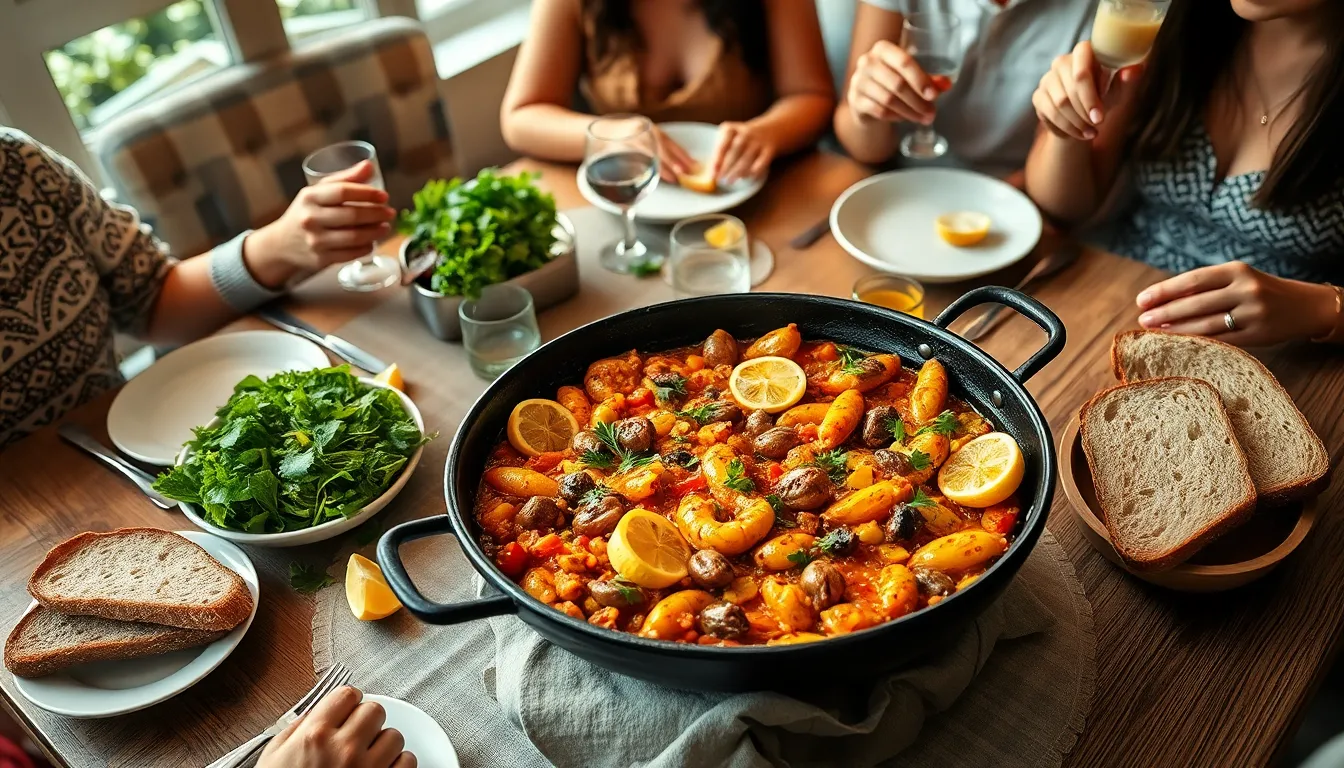
Your perfectly crafted paella deserves thoughtful presentation that honors its Spanish heritage. Serve your paella directly from the paellera at the table for an authentic communal dining experience that brings family and friends together around this centerpiece dish.
Traditional Spanish accompaniments enhance the paella’s rich flavors without overwhelming the main attraction. Start with a simple green salad dressed in olive oil and sherry vinegar to cleanse the palate between bites. Fresh crusty bread provides the perfect vehicle for soaking up any remaining saffron-infused broth from the pan.
Beverage pairings play a crucial role in complementing your paella’s complex flavors. Spanish wines work exceptionally well with different paella varieties:
| Paella Type | Wine Pairing | Alternative Options |
|---|---|---|
| Valencian | Tempranillo or Garnacha | Spanish Rosé |
| Seafood | Albariño or Verdejo | Cava or Champagne |
| Mixed | Monastrell or Rioja | Sangria |
Temperature considerations matter significantly when serving paella. Allow your guests to experience the contrast between the warm rice and the room temperature accompaniments. Serve immediately after the resting period while the socarrat remains crispy and the rice maintains its ideal texture.
Garnish options add visual appeal and fresh flavors to your presentation. Scatter fresh parsley leaves across the surface for color contrast. Lemon wedges arranged around the pan’s edge provide guests with citrus brightness to enhance each bite. Roasted red peppers cut into strips create additional visual interest while reinforcing the dish’s Spanish character.
Portion planning ensures everyone receives an adequate serving from your paellera. Calculate approximately 4-6 ounces of rice per person for a main course serving. Your 15-inch paellera feeds 6-8 people comfortably when served as the primary dish alongside salad and bread.
Timing your service creates the optimal dining experience. Announce dinner 5 minutes before the paella finishes resting so guests can gather around the table. This anticipation builds excitement while ensuring the dish reaches the table at peak temperature and texture.
Storage and Reheating
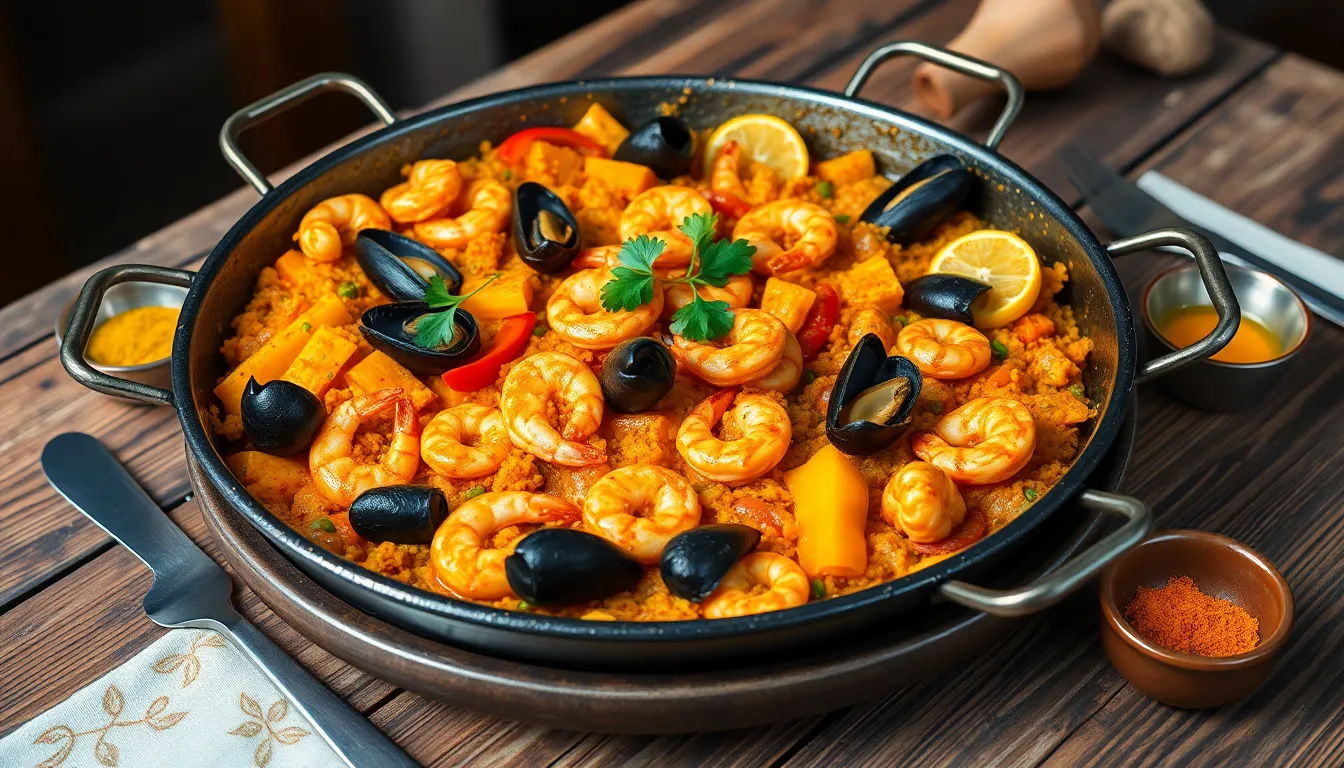
Proper storage techniques preserve your paella’s flavors and textures for future enjoyment. You should transfer leftover paella to airtight containers within two hours of cooking to maintain food safety. Refrigerate your paella immediately and consume within 3-4 days for optimal quality.
Refrigerator Storage
Store your paella in shallow containers to promote even cooling and prevent bacterial growth. You can keep the paella in portions or as one large container depending on your serving needs. Cover the containers tightly with plastic wrap or use airtight lids to prevent moisture loss and flavor contamination from other foods.
Remove any mussels or clams that remain closed before storing since these may spoil faster than other ingredients. Your paella will maintain its best quality when stored at temperatures below 40°F (4°C).
Freezer Storage
Freeze your paella for longer storage periods of up to 3 months. You should portion the paella into meal-sized containers before freezing to make reheating more convenient. Wrap containers in aluminum foil or freezer bags to prevent freezer burn and maintain flavor integrity.
Label your containers with the date and type of paella for easy identification. Seafood paella maintains better texture after freezing compared to mixed varieties with delicate vegetables.
Reheating Methods
Stovetop Method: Add 2-3 tablespoons of broth or water to your paella in a wide pan. Heat over medium-low temperature for 8-10 minutes while stirring gently to distribute moisture evenly. Cover the pan to create steam that will revive the rice texture.
Oven Method: Preheat your oven to 350°F (175°C) and transfer paella to an oven-safe dish. Add a few tablespoons of broth and cover tightly with foil. Heat for 15-20 minutes until warmed through completely.
Microwave Method: Place portions in microwave-safe dishes with a splash of broth. Cover with a damp paper towel and heat in 30-second intervals at 70% power. Stir between intervals to ensure even heating and prevent hot spots.
| Reheating Method | Temperature | Time | Best For |
|---|---|---|---|
| Stovetop | Medium-low | 8-10 minutes | Large portions |
| Oven | 350°F (175°C) | 15-20 minutes | Family servings |
| Microwave | 70% power | 1-3 minutes | Individual portions |
Avoid reheating paella multiple times as this compromises food safety and degrades texture quality. Your reheated paella should reach an internal temperature of 165°F (74°C) before serving to ensure it’s safe to eat.
Common Mistakes to Avoid
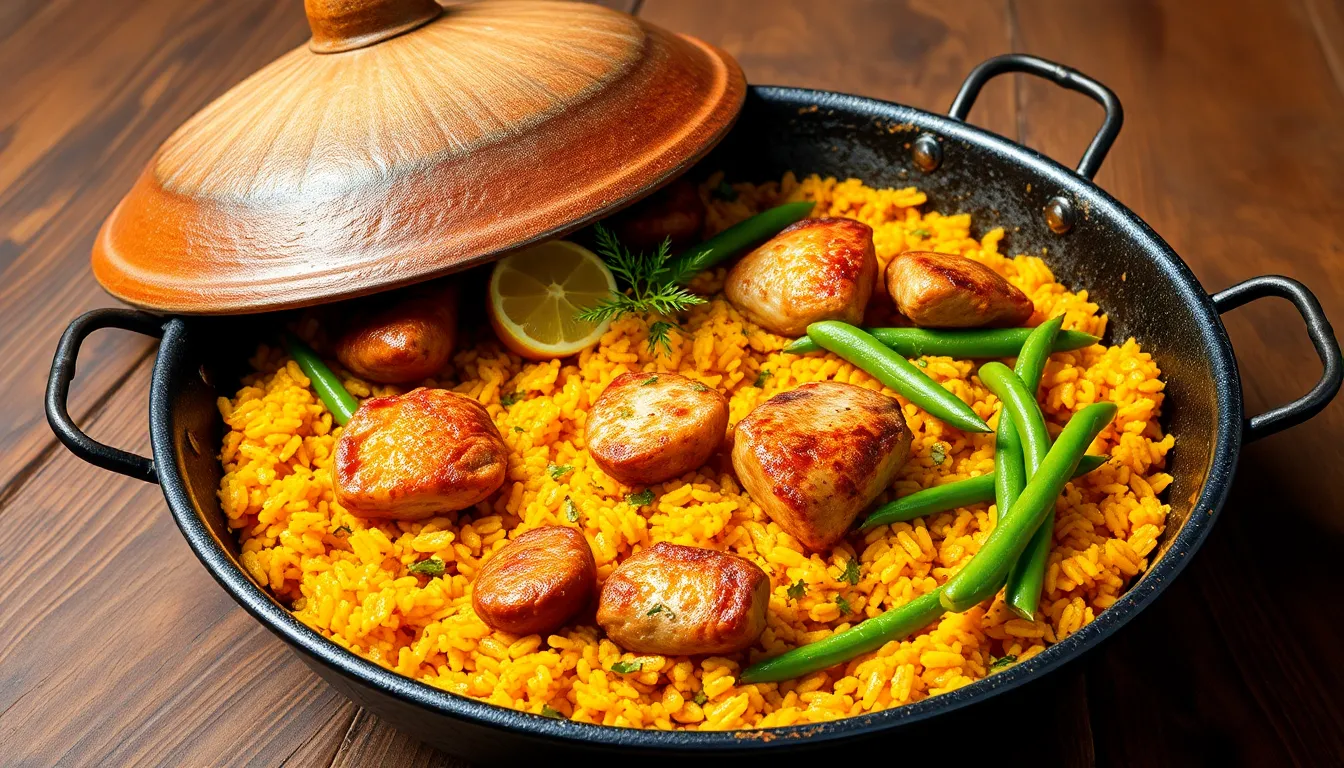
Using the Wrong Rice Type
Bomba rice or Spanish short grain rice creates the perfect texture for authentic paella. Long grain rice releases less starch and produces a dry result that lacks the creamy consistency characteristic of proper paella. Avoid arborio rice even though its popularity in risotto recipes since it releases too much starch and creates an overly creamy texture.
Stirring the Rice
Your rice should remain undisturbed once you add it to the pan. Stirring breaks the grains and creates a mushy texture similar to risotto rather than the distinct grain separation that defines paella. Allow the rice to absorb the broth naturally while maintaining its position in the paellera.
Adding Too Much Liquid at Once
Pour your warm broth gradually and allow each addition to absorb before adding more. Flooding the pan with liquid prevents proper absorption and creates uneven cooking. The rice should barely peek above the liquid surface when you finish adding broth.
Neglecting the Socarrat
Many home cooks fear burning the bottom layer and remove the paella too early. The socarrat requires increased heat during the final cooking minutes to create that coveted crispy layer. Listen for gentle crackling sounds and watch for steam reduction to know when the socarrat forms properly.
Overcrowding with Ingredients
Authentic paella follows exact ingredient combinations rather than kitchen sink additions. Traditional Valencian paella contains only rabbit, chicken, lima beans, green beans and sometimes snails. Adding chorizo, peas or mixed vegetables contradicts authentic preparation methods and muddles the intended flavors.
Using Cold Broth
Cold broth stops the cooking process and creates uneven rice texture. Keep your chicken or seafood broth simmering in a separate pot throughout the cooking process. Warm broth maintains consistent temperature and ensures proper rice absorption.
Choosing the Wrong Pan Size
Your paellera diameter determines serving portions and cooking success. A 15-inch pan serves 6-8 people while a 12-inch pan accommodates 3-4 servings. Using an oversized pan spreads ingredients too thin while undersized pans create thick rice layers that cook unevenly.
Rushing the Cooking Process
Paella demands patience and cannot be hurried without sacrificing quality. Allow 20-25 minutes for proper rice cooking after adding the broth. Attempting to speed up the process with higher heat burns the bottom before the rice finishes cooking properly.
Skipping the Resting Period
Remove your paella from heat and cover with a clean kitchen towel for 5-10 minutes before serving. This resting period allows residual heat to finish cooking any remaining firm grains and helps flavors meld together for the final result.
Conclusion
You now have everything you need to create authentic paella that’ll transport your taste buds straight to Spain. Remember that mastering this iconic dish takes practice but the reward is worth every effort you put in.
Your paella journey doesn’t end with your first attempt. Each time you cook this remarkable dish you’ll discover new nuances and develop your own personal touch while respecting the traditional techniques.
Whether you choose the classic Valencian style or venture into seafood variations you’re participating in a centuries-old culinary tradition. Your kitchen will become a gateway to Spanish culture and your dining table a place where memories are made.
So fire up that paellera gather your loved ones and let the magic of authentic paella bring everyone together. You’ve got this!

